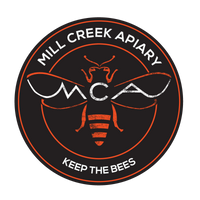What’s Propolis?
Commonly called “bee glue,” propolis is a sticky, resinous substance produced by honey bees, specifically Apis mellifera, which is the Western or European honey bee. There are several subspecies of Apis mellifera in different regions of the world. Though they were not native to North America, this is the honey bee found here now.
Honey bees use propolis to seal holes and cracks, reduce entry ways, generally smooth over surfaces, and to embalm invaders in the hive. It also prevents unwanted airflow and maintains a stable temperature and humidity level. Propolis is highly antimicrobial and acts as a disinfectant for the bees. (Keep an eye out for our upcoming blog post about the benefits of propolis!) It keeps bacteria out and helps ensure a healthy hive, despite honey bee numbers reaching 60,000+ in a single hive! [1]
Propolis is soft and workable in warm temperatures, but will become brittle when it freezes, which is the easiest state for people to work with it. Its contents vary depending on the region, season, and colony, likewise affecting color and smell. Color can range from red, green, black, or yellow, but it’s most often a shade of brown. Scent differs as well, a combination of piney, fruity, floral, spicy, minty, and/or vanilla notes. [2] The propolis we collect here at Mill Creek Apiary is generally a medium brown and smells of mostly pine and vanilla (though our expertise is in bees, not perfumery!)
How is it Made?
The main component in propolis is resin from tree buds, leaves, or other plant material. Honey bees collect resin with their mandibles and store it in pockets on their hind legs. In their return to the hive, other bees help remove it because it’s so sticky! [1] These resins are mixed with saliva and wax for the final product. [3]
In temperate regions, including North America, Europe, and parts of Asia, poplar trees are the primary source of resin. Pine, alder, chestnut, beech, willow, and others may also be used. It’s highly dependent on what’s most available to any given hive. For example, the green propolis that bees produce in parts of Brazil has been shown to come from the resin of Baccharis dracunculifolia, a type of shrub. [4] In northeastern Brazil honey bees make red propolis from Dalbergia ecastaphyllum. [5]
A Deeper Dive
To truly understand all of the components of propolis, it would require entering a chemistry rabbit hole. The sources below will do that for you, but let’s at least dip our toes in here! Propolis is composed of roughly 50% resins, 30% wax, 10% aromatic compounds and essential oils, and 5% pollen. The other 5% includes vitamins, minerals, sugars, and other organic compounds. [1,6,7] The exact composition of propolis is very diverse; it’s relative to the region, season, precise location of the hive, and the bees themselves.
Resins, as earlier discussed, come from tree buds, leaves, or other plant material. Studies have proven that the bioactive compounds in propolis come from the resin rather than from any alteration by honey bees. [7] Flavonoids and phenolic acids are two important groups of compounds that are found in resin. Flavonoids have antibacterial, antiviral, and anti-inflammatory effects, among others. Over 100 flavonoids have been identified in propolis globally. Some common ones include chrysin, pinocembrin, galangin, and quercetin. [6] Over 70 phenolic acids have been identified, and they generally offer high antioxidant activity. [7] Specifically, caffeic acid phenethyl ester is an important phenol in temperate region propolis, while artepillin C plays a crucial role in green Brazilian propolis. [6]
Essential oils contain terpenes. Terpenes are aromatic compounds that are responsible for scent and taste, and display antioxidant and antimicrobial properties. Over 50 terpenes have been identified in propolis, and they can be used to differentiate high quality propolis from fake or low quality. [6] Even if you are not well versed in terpenes, some found in propolis may look familiar to you. For example, you may be able to guess that alpha-pinene (α-pinene) is mainly responsible for the scent of pine, and e-ethyl cinnamate is responsible for the smell of cinnamon! [2]
Pollen is comprised of amino acids and proteins. Vitamins B1, B2, B6, C, and E have been identified in propolis. [1] Mineral composition varies and can be useful in determining propolis’ location of origin. [6] Sugars are believed to come from cross contamination with nectar. [7]
What’s the significance?
As mentioned, propolis contains multiple compounds that make it antimicrobial, anti-inflammatory, and a powerful antioxidant. This is not only beneficial to the bees, but to humans! Soon we’ll be discussing the history of human use of propolis, and then modern studies, including cancer prevention and treatment, and in regard to COVID-19. Look out for our products containing propolis, coming soon!
Sources
- Historical Aspects of Propolis Research in Modern Times
- ID of key aromatic compounds in NJ propolis over 3 years
- Chemical Compositions of Propolis from China and the United States and their Antimicrobial Activities Against Penicillium notatum
- Brazilian Green Propolis: Anti-Inflammatory Property by an Immunomodulatory Activity
- Brazilian Red Propolis—Chemical Composition and Botanical Origin
- Recent Advances in the Chemical Composition of Propolis
- Plant Sources Responsible for the Chemical Composition and Main Bioactive Properties of Poplar-Type Propolis

Leave a comment